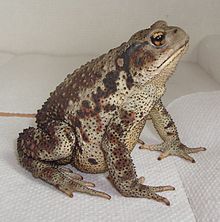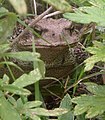
The common toad, European toad, or in Anglophone parts of Europe, simply the toad, is an amphibian found throughout most of Europe, in the western part of North Asia, and in a small portion of Northwest Africa. It is one of a group of closely related animals that are descended from a common ancestral line of toads and which form a species complex. The toad is an inconspicuous animal as it usually lies hidden during the day. It becomes active at dusk and spends the night hunting for the invertebrates on which it feeds. It moves with a slow, ungainly walk or short jumps, and has greyish-brown skin covered with wart-like lumps.
Bufotoxins are a family of toxic steroid lactones or substituted Tryptamines of which some may or may not be toxic. They occur in the parotoid glands, skin and venom of many toads and other amphibians, and in some plants and mushrooms. The exact composition varies greatly with the specific source of the toxin. It can contain 5-MeO-DMT, bufagins, bufalin, bufotalin, bufotenin, bufothionine, epinephrine, norepinephrine, and serotonin. Some authors have also used the term bufotoxin to describe the conjugate of a bufagin with suberylarginine.

The Colorado River toad, also known as the Sonoran Desert toad, is found in northern Mexico and the southwestern United States. It exudes toxins from glands within its skin, including the psychoactive substances 5-MeO-DMT and bufotenin.

The American toad is a common species of toad found throughout Canada and the eastern United States. It is divided into three subspecies: the eastern American toad, the dwarf American toad ,p and the rare Hudson Bay toad. Recent taxonomic treatments place this species in the genus Anaxyrus instead of Bufo.
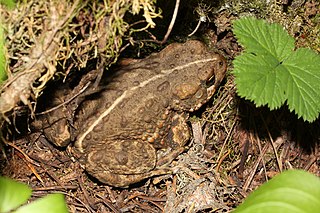
The western toad is a large toad species, between 5.6 and 13 cm long, native to western North America. A. boreas is frequently encountered during the wet season on roads, or near water at other times. It can jump a considerable distance for a toad. Breeding occurs between March and July in mountainous areas, and as early as January in lower-elevation regions. The female lays up to 17,000 eggs stuck together in strings that adhere to vegetation and other objects along water edges.
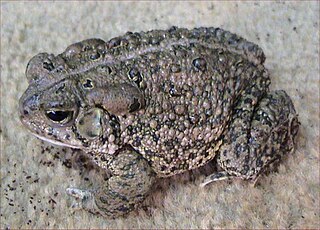
Woodhouse's toad is a medium-sized true toad native to the United States and Mexico. There are three recognized subspecies. A. woodhousii tends to hybridize with Anaxyrus americanus where their ranges overlap.

The North American green toad, Anaxyrus debilis, also known by its old name Bufo debilis, is a species of toad found in the southwestern United States in the states of Arizona, New Mexico, Colorado, Kansas, and Texas, as well as in northern Mexico in the states of Tamaulipas, San Luis Potosí, Durango, and Zacatecas. It is commonly called green toad.

The Mongolian toad, also known commonly as the piebald toad or the Siberian sand toad, is a species of toad in the family Bufonidae. The species is endemic to northeastern Asia. It was formerly placed in the genus Bufo, then for a few years in Pseudepidalea until finally moved to its own genus Strauchbufo.

Bufo bankorensis is a species of toad in the family Bufonidae. It is endemic to Taiwan and widely distributed at elevations up to 3,000 m (9,800 ft) above sea level. There has been doubts about its separatedness from Bufo gargarizans from China and even other species, but it is currently considered a valid species.
Rhinella humboldti is a species of toad in the family Bufonidae. It is found in Colombia, Venezuela, Trinidad, and the Guianas. This species was originally considered to be a subspecies of Rhinella granulosa.
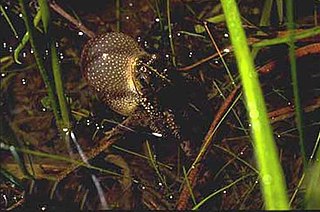
Rhinella dorbignyi is a South American species of toad in the family Bufonidae. The specific name, dorbignyi, is in honor of French naturalist Alcide d'Orbigny. Its common name is d'Orbigny's toad or Dorbigny's toad [sic].

The Japanese common toad, Japanese warty toad or Japanese toad is a species of toad in the family Bufonidae. It is endemic to Japan. Its natural habitats are subarctic forests, temperate forests, temperate shrubland, swamps, freshwater marshes, intermittent freshwater marshes, freshwater springs, arable land, rural gardens, urban areas, ponds, and irrigated land.
Bufotes pseudoraddei is a species of toad in the family Bufonidae. It is found in the West Himalayan region, including northern Pakistan and the border area between western Xizang of China and adjacent northwestern India. Its natural habitats are temperate forests, intermittent freshwater marshes, arable land, pastureland, plantations, and rural gardens.

The Korean brown frog is a species of frog in the genus Rana. It is native to the Korean Peninsula and Shandong, China.
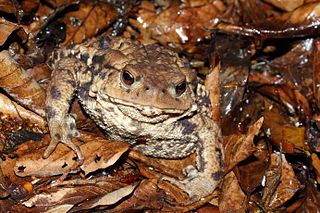
Bufo eichwaldi, commonly known as Eichwald's toad or the Talysh toad, is a species of true toads in the family Bufonidae. It was first described by Litvinchuk, Borkin, Skorinov and Rosanov in 2008 and is found in the Talysh and Elburz Mountains in Azerbaijan and parts of northern Iran. It was previously considered to be a subspecies of the Caucasian toad.

Robert Frederick Inger was an American herpetologist.
